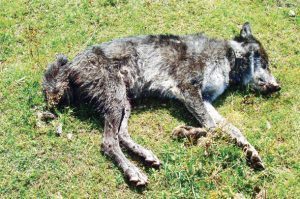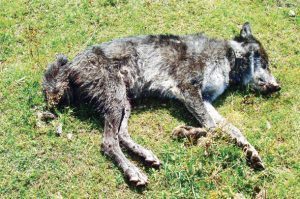 Looks like Oregon will try to decrease depredation amount to 3 after Washington set theirs at 4. on Slaughtering wolves from above! We need to act, and we need to act Fast, before Our Sacred Wildlife are non-existent at the hands of greedy Ranchers across Wolf inhabited states. Join us to act now, before we witness untold amount of Dead Wolves at the hands of Ranchers.
Looks like Oregon will try to decrease depredation amount to 3 after Washington set theirs at 4. on Slaughtering wolves from above! We need to act, and we need to act Fast, before Our Sacred Wildlife are non-existent at the hands of greedy Ranchers across Wolf inhabited states. Join us to act now, before we witness untold amount of Dead Wolves at the hands of Ranchers.
The Oregon Fish and Wildlife Commission will consider a variety of changes as it completes its five-year review of the Oregon Wolf Conservation and Management Plan.
Russ Morgan, Oregon Department of Fish and Wildlife’s wolf coordinator, outlined 10 issues under review at the Wildlife Commission’s October meeting Friday at the Blue Mountain Conference Center in La Grande.
“The review is not a rewrite, but the commission may amend the plan as a result of (th e) review,” Morgan said.
The plan is based on an adaptive principle, Morgan said, allowing managers to apply what’s been learned over the years as wolves increase their territory across the state. Following this line of thought, Morgan said the state is considering the establishment of benchmarks to manage wolves in smaller regions than a wildlife unit, which can be hundreds of thousands of acres in size.
“The plan does contemplate establishing smaller zones and population objectives. The idea of developing geographic areas like we do with a number of wildlife isn’t new,” Morgan said.
Dennis Sheehy, a rancher based in Wallowa whose cattle summer graze on the Wallowa-Whitman National Forest in the heart of the Imnaha pack’s historic range, said he supported the establishment of zones.
“I think an important point in reducing conflict is the development of management zones for wolves where you can look at all the different aspects as a unit to come up with solut ions that fit a particular area,” Sheehy said.
The most contentious possibility under Phase 3 of the wolf plan, triggered when seven breeding pairs are documented for three consecutive years, is what the state calls “directed take.”
The curr ent plan includes the option of “directed take” in very specific situations of chronic livestock loss to wolves and impacts to wild hoofed animals, Morgan said.
He said the provision is not intended to manage or limit the population, no general hunting seasons would be allowed and it does not replace the requirement of nonlethal efforts to minimize depredations.
Arguing against what he called “trophy hunting,” Rob Klavins, of Oregon Wild, said he and others in the environmental community have been disenfranchised by the Fish and Wildlife Commission’s premature decision to delist wolves.
“The division is deep, wide and growin g,” Klavins said.
Fearing livestock producers will have too much freedom to errantly kill wolves, Peter Barry of Joseph said, “The ranchers I know shoot everything. They are not special Americans; they are a tiny minority. A vast majority of Oregonians want wolves and they want a lot of wolves.”
Wallowa County Stockgrowers and the Oregon Cattlemen have asked the state to determine a firm number of confirmed wolf-caused livestock kills before the state can take lethal action. Morgan said he is suggesting a minimum of three livestock depredations in a 12-month period.
Todd Nash, Oregon Cattlemen’s Association wolf committee chair, said he supports removing problem wolves and wants the state to have a quicker response.
“The Imnaha pack had 42 confirmed kills before it was taken out,” Nash said.
As wolf populations increase, Morgan said, it is becoming more difficult to get a radio collar on a wolf in every pack as the plan suggests. Nash asked the state to continue an aggressive collaring campaign and to communicate GPS collar information in as close to real time as possible.
Susan Roberts, Wallowa County Board of Commissioners chairman, said some of the county’s livestock producers are suffering economic loss due to wolves.
“It’s important to the county commission that we have a collar on every single pack out there,” Roberts said.
Another bone of contention between activists and producers is who can conduct a livestock kill or injury investigation.
“We don’t have an issue with ODFW going out on an initial investigation,” Nash said. “We feel comfortable with them making the initial call. It’s the controversial calls (for which) we would like an outside review.”
Curt Melcher, state director for Fish and Wildlife, said if there was agreement to have a third party review system, the agency would have to appoint the committee.
“As wolves continue to expand in Oregon, we need to manage wolves as we do all wildlife, by making day to day management decisions at local, field level,” Melcher said.
Morgan said so far this year state biologists have conducted 54 investigations.
“That’s more than we’ve done in any year, and we have 2-1/2 months left,” Morgan said. “It becomes an issue of who can help us out when there are suspected wolf depredations.”
